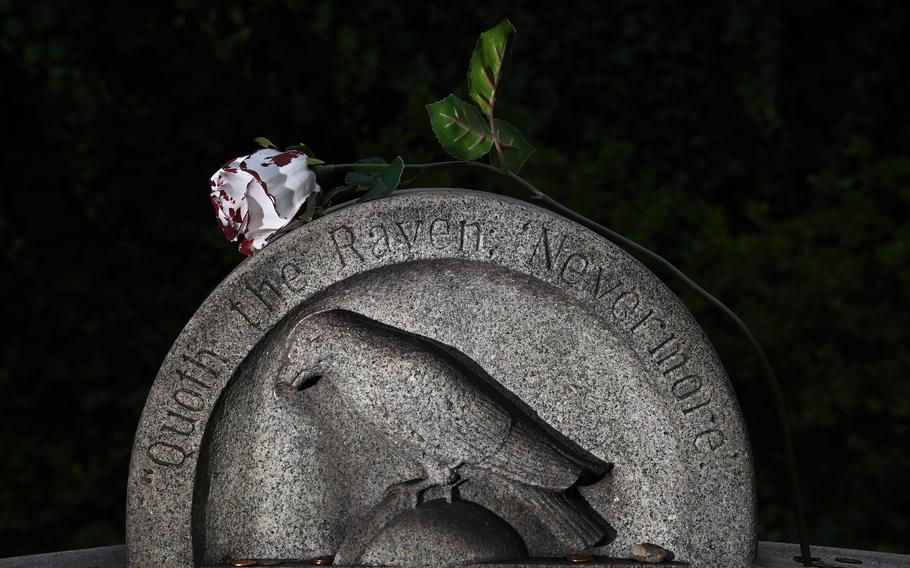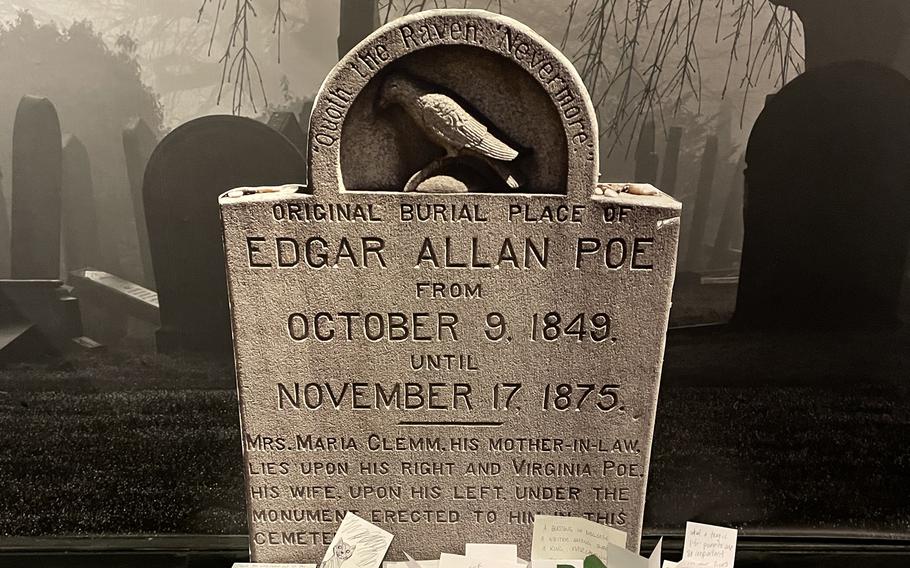
A headstone at Edgar Allan Poe’s original gravesite at Westminster Presbyterian Church and Cemetery in Baltimore, where he died in 1849. Poe’s body was moved to another site at the entrance to the cemetery. (Matt McClain/Washington Post)
What if Edgar Allan Poe had remained at West Point in 1831? Would the “Master of Macabre” — the acclaimed author of short stories and gothic horror fiction — be remembered today as a great military leader, perhaps a top officer in the Civil War?
The new Netflix movie “The Pale Blue Eye” gives us an excuse to dwell on that possibility. The fictional film tells the story of a former New York City policeman played by Christian Bale searching for clues to a gruesome crime at the U.S. Military Academy in West Point, N.Y., in 1830. He is ably assisted in the investigation by none other than young cadet Poe, portrayed by Harry Melling.
Based on the 2003 novel by Louis Bayard, the murder mystery is nothing but fantasy - except for the part about Poe. He did attend the military academy then — just after Robert E. Lee and before Ulysses S. Grant and William Tecumseh Sherman — with the intention of becoming a commissioned officer in the Army. Perhaps better for literature’s sake, his aspirations were not fulfilled.
Born in Boston in 1809, Poe was orphaned after his father abandoned the family when he was 3 and his mother died a year later. The youngster went to live with John and Frances Allan (hence the poet’s middle name) in Virginia, and they sought to raise him as a “Southern Gentleman,” according to writer Allen Tate.
By all accounts, Poe rarely lived up to that ideal. He had a fondness for drink, betting and women. His impropriety may have actually led him to join the Army. Poe had a falling out with his foster father, who objected to the young man’s gambling and other debts. The aspiring poet attended the University of Virginia in 1826 but soon left after Allan refused to cover his “exorbitant expenditures,” wrote Robert D. Jacobs in a 1969 article.
Poe enlisted in the Army in Boston in 1827. He listed his age as 21, although he was really 18, and his name as Edgar A. Perry.

Edgar Allan Poe is buried in Baltimore, but visitors to the Poe Museum in Richmond can leave notes for him at his “gravesite.” (Andrea Sachs/Washington Post)
In the military, he seemed to flourish. He quickly rose through the ranks to become an “artificer” — a special rank reserved for expert artillerymen — with Company H of the 1st Artillery Regiment at Fort Independence in Massachusetts. Soon after, he was promoted ahead of 500 other enlisted men to sergeant major, the highest Army rank for a noncommissioned officer.
Poe biographers have written that the future poet “distinguished himself” and “pleased his superiors” in his “successful” military tenure, according to Michael L. Howard in a 2003 article in the Army Space Journal.
Poe also believed he was well suited for the military. “My character is one that will bear scrutiny and has merited the esteem of my officers,” he wrote in a letter to Allan in 1828.
While his lack of income was certainly a factor, Poe may have been driven to join the Army because of the example of his grandfather. During the Revolutionary War, David Poe served as a quartermaster under George Washington. The grandson also had been a lieutenant in a junior militia group that escorted the Marquis de Lafayette on his visit to Richmond in 1824, when Poe was 15.
In 1829, Poe was released from his five-year enlistment in the Army so he could become a cadet at West Point, securing an appointment from President Andrew Jackson - this time under his legal name. After reconciling with his foster father, he reported for duty on July 1, 1830, at the military academy overlooking the Hudson River.
At first, Poe did well, but his fondness for West Point soon waned. Some historians speculated he failed to make the grade at the academy. Fellow cadet Thomas Pickering Jones later wrote that “Poe was a brilliant student, but had an aversion to mathematics, and that his inability to do well in that subject made him decide to leave West Point.”
Other factors may have led to his departure, however. Poe had another argument over money with Allan, who removed his foster son from his will. In addition, Poe, who had thought he would receive a commission as an officer after only six months at the academy because of his previous enlistment, learned he would have to remain at West Point for a full four years.
According to Howard, “Poe then purposely set out to gain a discharge.” He stopped attending classes and ignored commands from superiors. According to one legend, Poe was ordered to show up for drill “with cross belts and under arms,” which he did - but wearing nothing else, as reported in “Last in Their Class: Custer, Pickett and the Goats of West Point” by James S. Robbins.
Au naturel or not, Poe’s dereliction had the desired effect. He was dismissed from West Point on March 6, 1831, after a court-martial for neglecting duties and disobeying orders.
Soon after moving to Baltimore, he published another book of poetry - partly funded by his West Point classmates - with the inscription, “To the U.S. Corps of Cadets this volume is respectfully dedicated.”
The Army’s loss was literature’s gain. Poe would go on to become one of the most influential writers of the 19th century, best known for his short stories of Gothic horror and poems of love and loss with supernatural overtones. He is considered the creator of detective fiction and an early contributor to the genre of science fiction.
As Poe’s celebrity as a writer rose, so did his drinking and inclination toward other vices. He died mysteriously at age 40 in 1849, leaving a lasting legacy in literature, if not in the military.